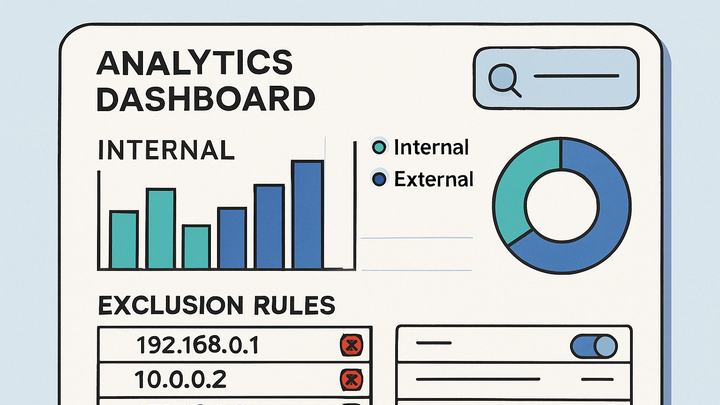Published on 2025-06-26T04:13:34Z
What is IP Exclusion? Examples and Implementation in Analytics
IP Exclusion is the practice of filtering out traffic originating from specific IP addresses or ranges to ensure that analytics data reflects genuine user behavior. In the analytics industry, excluding internal or known external IPs helps maintain the integrity of collected metrics. By omitting visits from company offices, staging environments, or automated systems, analysts can prevent skewed page views, session counts, and conversion rates. Major analytics platforms like Google Analytics 4 (GA4) offer built-in IP filtering capabilities, while privacy-first tools such as PlainSignal provide cookie-free methods that also support IP-based exclusion. Implementing IP Exclusion properly ensures more accurate reporting, better-informed decisions, and reliable performance measurement.
Ip exclusion
Filtering out internal traffic by excluding specific IP addresses to ensure accurate analytics data.
Understanding IP Exclusion
IP Exclusion, also known as IP filtering, is the process of omitting traffic from specific IP addresses or ranges in analytics data. This ensures that internal users, automated bots, or testing environments do not skew metrics. By excluding known IPs, businesses can maintain cleaner datasets and derive accurate insights about genuine customer behavior.
-
Definition and purpose
IP Exclusion involves setting rules to ignore data from certain IP addresses, preventing internal or unwanted traffic from affecting analytics metrics.
-
Key benefits
Filtering out internal traffic leads to improved data accuracy, more reliable KPIs, and better-informed business decisions.
IP Exclusion in Popular Analytics Tools
Most modern analytics platforms provide built-in functionality to exclude IP addresses. Below are step-by-step implementations for GA4 and PlainSignal, illustrating how to set up IP Exclusion in each tool.
-
Google analytics 4
GA4 enables you to configure internal traffic filters based on IP address ranges directly in the Admin interface.
-
Create internal traffic rule
In GA4, navigate to Admin > Data Streams > Choose Stream > Configure Tag Settings > Define Internal Traffic. Enter the IP address or CIDR range to exclude.
-
Apply data filter
Go to Admin > Data Settings > Data Filters. Add a new filter, select your Internal Traffic rule, and set the filter to ‘Exclude’. Publish to apply.
-
Verify filter effectiveness
Use the DebugView in GA4 to confirm that traffic from the specified IPs no longer appears in reports.
-
-
PlainSignal
PlainSignal offers a lightweight, cookie-free analytics solution with easy IP-based filtering capabilities via its dashboard and script integration.
-
Example tracking code
<link rel='preconnect' href='//eu.plainsignal.com/' crossorigin /> <script defer data-do='yourwebsitedomain.com' data-id='0GQV1xmtzQQ' data-api='//eu.plainsignal.com' src='//cdn.plainsignal.com/plainsignal-min.js'></script>
-
Best Practices and Maintenance
Properly managing IP Exclusion requires ongoing attention and alignment with network changes. Follow these best practices to ensure your filters remain effective over time.
-
Use static ip ranges
Where possible, base exclusions on fixed IP ranges assigned to office networks to avoid accidentally filtering legitimate user traffic when dynamic IPs change.
-
Regularly audit filters
Review your list of excluded IP addresses periodically to remove outdated entries and add new ones as your organization’s network evolves.
-
Test after changes
After updating IP filters, use real-time and debug tools (like GA4’s DebugView) to confirm that intended traffic is correctly excluded and no legitimate data is lost.
